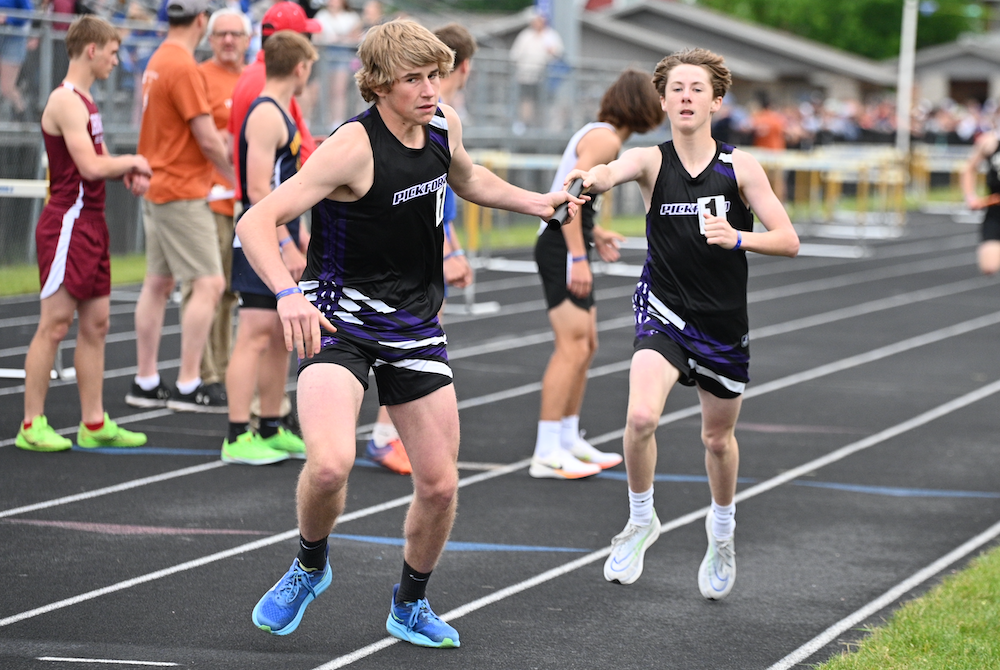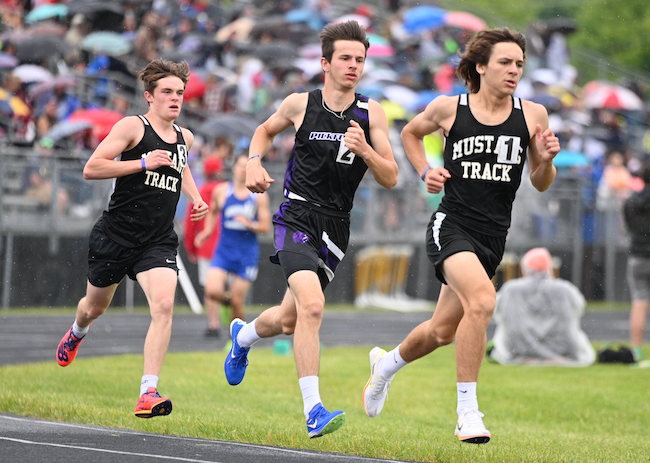
Add, Subtract, Divide, Multiply: MHSAA Not Alone
July 25, 2017
By Rob Kaminski
MHSAA benchmarks editor
This is the third part in a series on MHSAA tournament classification, past and present, that will be published over the next two weeks. This series originally ran in this spring's edition of MHSAA benchmarks.
As the MHSAA faces its most recent classification task with 8-Player Football, and opinions continue to swirl about as to the method, timeframe, location and other procedures, a look around the country provides plenty of company among state association brethren factoring variables into their own equations.
In the Pacific Northwest, the Oregon School Activities Association Football Playoffs are under public scrutiny as leadership ponders a five or six classification format beginning with the 2018-19 school year.
The OSAA has crowned six champions on the gridiron since 2006-07. Many of the state’s smaller schools would like to keep it that way, while larger schools lean toward a five-classification system, citing larger leagues, ease of travel and credibility to state championships as the advantages.
Still others would prefer more than six classes, pointing to safety issues and the opportunity to increase participation numbers as positives.
Moving southeast of Oregon, the Nevada Interscholastic Activities Association recently voted to hold serve on a classification proposal that was volleyed to the membership.
However, changes still could be forthcoming by as early as the 2018-19 season which would add a fifth classification in more populated southern Nevada while allowing northern schools to participate in four classifications. Such divisions could mean no state championship for the fifth class in southern Nevada.
Because of that, the NIAA wants equal numbers of schools in each classification on both ends of the state. Complicating the issue is the fact that the 24 largest schools in the state, by enrollment, are all in Clark County in Southern Nevada.
Across Nevada’s border into Arizona, charter schools are asking the Arizona Interscholastic Association to reconsider classification that was voted upon and approved in September 2015. That agreement called for the largest 33 percent of charter schools by enrollment to be placed in the state’s largest school classification, 3A, the middle 33 percent into 2A, and the smallest 33 percent into 1A.
Less than two years later the charter schools have had a change of heart and have asked to be considered the same as other Arizona public schools and be placed appropriately by enrollment beginning with the 2018-19 school year.
The situation in Arizona further illustrates how the public/private debate that all state associations have faced throughout existence now has the added dynamic of rapidly growing charter schools in today’s educational system, along with virtual school enrollment.
In the nation’s heartland, Nebraska has retooled its football classifications by using enrollment of boys students only in its schools rather than total enrollment. The Nebraska School Activities Association football-playing schools will kick off the 2018 season using this alignment.
Nebraska has three classes of 11-player football, with the smallest class divided in two, Class C-1 and C-2. The state also will have 8-player football for boys enrollments under 47, and the NSAA will sponsor a new 6-player tournament in 2018 for schools with 27 or fewer boys.
“This is a good proposal because some schools have a sizable imbalance between the number of boys and girls, and there’s a large gap (in enrollment) between the largest and smallest schools in Classes A and B,” NSAA executive director Jim Tenopir said. “I think this addresses both of those concerns.”
Swimmers in Georgia, meanwhile, will feel like they are moving with the current, rather than upstream in 2017-18, as the Georgia High School Association recently doubled the number of team championship events from two to four.
Swim enthusiasts can also count on longer days at the finals, as the top 30 finishers from the prelims will advance to the finals instead of 20, and all championship events will have three heats versus two.

Pickford Wins Matchup of Reigning Champions to Run Title Streak to 3
By
John Vrancic
Special for MHSAA.com
June 2, 2024
KINGSFORD — The Pickford boys extended their championship reign here Saturday, retaining top honors at the Upper Peninsula Division 2 Track & Field Finals with 137 points.
They were followed by Munising with 106 and Ishpeming with 79. The team championship was the Panthers’ third straight, as they also won Division 3 in 2022.
Sophomore Gunner Bennin was a double-winner for Pickford, taking the 200-meter dash in 23.85 seconds and 400 at 53.36.
“It feels great to come here and win a couple events as a sophomore,” he said. “We knew Iron Mountain had some good sprinters, and Munising is tough. We needed the points. I started faster than I usually do, especially in the 400.
Senior Hayden Hagen provided the Panthers with a first in the 800 (2:05.03), and sophomore John Anderson won high jump at 5 feet, 8 inches.
Panthers junior Tom Storey was runner-up in pole vault (10-6) and high jump (5-7). Hagen was runner-up to Munising junior Dan Goss in the 1,600 (4:39.84) and 3,200 (10:30.81).
Goss ran a personal-best 4:33.98 in the 1,600 and was clocked at 10:23.9 in the 3,200, and anchored the winning 3,200 relay (8:50.22).
 “I like the weather today,” he said. “It was a little humid during the 3,200. Otherwise, it was a good day for running. That was a 10-second PR (personal record) in the 1,600. I’m real happy with that. I’ve been training my tail off the last two weeks.
“I like the weather today,” he said. “It was a little humid during the 3,200. Otherwise, it was a good day for running. That was a 10-second PR (personal record) in the 1,600. I’m real happy with that. I’ve been training my tail off the last two weeks.
“The field events hurt us, but overall I’m happy with how our team did. I had a PR in every event including a split of 2 minutes flat in the 3,200 relay.”
Munising – the Division 3 champion in 2023 – also took the 800 relay (1:36.19), and Pickford was runner-up (1:38.18). The Panthers claimed the 1,600 relay (3:43.36) and placed second in the 3,200 (8:52.74).
Munising senior Joe Kelley added firsts in the 110 hurdles (16.46) and the 300s (42.12) and helped the Mustangs take second in the 400 relay (46.19) and 1,600 (3:48.86). Mustangs’ senior Trevor Nolan added a third in the 1,600 (4:43.41), followed by Bark River-Harris freshman Ben Knauf in a personal-best 4:48.04.
Ishpeming got a first on senior Brayden Martin’s throw of 123-9¼ in discus, and Hancock senior Myles Lewis took shot put (42-11½).
The Hematites got seconds from senior Tramon Gauthier in long jump (18-7¾), 110 hurdles (16.47) and 300s (43.62), and freshman Kemper Gearhart was third in the 3,200 (10:41.5).
Ironwood sophomore Talon Hughes placed second in the 100 (11.51) and 200 (23.98) and third in the 110 hurdles (16.55).
Iron Mountain senior Matt Colavecchi had a hand in three firsts, taking the 100 (11.44), long jump (19-8¼) and anchoring the winning 400 relay (45.92).
Rudyard got a first on junior Jaydon Niemi-Alcorn’s leap of 11-6 in pole vault. Taking runner-up for the Bulldogs were senior teammate Kaeden Sistrunk in shot put (40-8) and junior Ethan Hoolsema in discus (120-0).
PHOTOS (Top) Pickford's Jacob Mitchell hands off the baton to Eli MacDonald for the last leg of the 3,200 relay Saturday at Kingsford. (Middle) During a rainy 1,600, Munising's Dan Goss (1) leads the race with Pickford's Hayden Hagen (2) and Munising's Trevor Nolan (3) right behind him. (Click for more from Cara Kamps/RunMichigan.com.)

